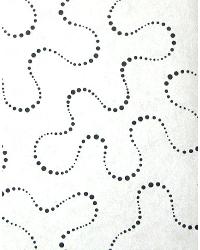Commercial Wallpaper History
Wallpaper is a nonwoven (paper) or woven (fabric) backing, decoratively printed for application to walls of a residence or business. Wallpaper is not considered essential to the decoration of a structure; however, it has become a primary method by which to impart style, atmosphere, or color into a room.
The wallpaper industry divides the manufacture of wallpaper into those used in residences and those hung in businesses or other public buildings. The two categories of paper differ in weight, serviceability, and quality standards. Residential-use wallpapers are made from various materials and can be purchased prepasted or unpasted. There are no mandated serviceability tests for residential papers. The commercial-grade wallpapers are divided into categories based on weight, backing composition, and laminate/coating thickness. All commercial-use wallpapers must have a vinyl surface and pass rigorous physical and visual tests as mandated by the Chemical Fabrics and Film Association.
There are four popular methods used to print wallpapers, and designers choose the printing technique based on cost as well as aesthetics.
History
The earliest wallpapers used in Europe as early as the thirteenth century were painted with images of popular religious icons. These "domino papers" were pasted within homes of the devout; however, they also enlivened the bleak homes of the poor. Within the next few centuries, papers were hand block-printed, but only remained popular with the poor.
By the sixteenth century, however, more expensive wallcovering, depicting tapestries hung in homes of nobility, became popular with the middle class. Small sheets either carried a repeating image, or several blocks produced a pattern spread across many sheets. Fashionable eighteenth century Americans puchased wallpapers from France and England; "paper stainers" were producing wallpapers in this country by the early nineteenth century if not before.
Two problems plagued wallpaper stainers until the mid-nineteenth century. One was the problem of producing long sheets of paper for printing, the other was printing attractive wallpaper inexpensively. Until the mid-1700s, rag-based paper was individually printed in sheets, then applied to walls. Then, wallpaper manufacturers were pasting the pieces together, ground coating them, then printing. In the late nineteenth century, the paper industry developed "endless" paper, or paper made in very long strips. By 1870, wood pulp had supplanted rag stock, resulting in a very cheap backing for wallcovering.
In the nineteenth century, printing costs were greatly reduced by abandoning labor-intensive block printing in favor of cylinder printing. Wood-block printers applied each color by hand using a separate block for each color in the pattern. Thus, each block had to be inked with the right color, pressed down on the paper, tapped to ensure a quality imprint, lifted up, and reinked as the printer moved down the paper roll—an expensive process. Wood blocks were supplanted by copper cylinders, which carried the design below the surface of the roll, each roll printing a single color.



 Commercial Wallpaper
Commercial Wallpaper Commercial Wallpaper
Commercial Wallpaper Commercial Wallpaper
Commercial Wallpaper Commercial Wallpaper
Commercial Wallpaper
Wallpaper is a nonwoven (paper) or woven (fabric) backing, decoratively printed for application to walls of a residence or business. Wallpaper is not considered essential to the decoration of a structure; however, it has become a primary method by which to impart style, atmosphere, or color into a room.
The wallpaper industry divides the manufacture of wallpaper into those used in residences and those hung in businesses or other public buildings. The two categories of paper differ in weight, serviceability, and quality standards. Residential-use wallpapers are made from various materials and can be purchased prepasted or unpasted. There are no mandated serviceability tests for residential papers. The commercial-grade wallpapers are divided into categories based on weight, backing composition, and laminate/coating thickness. All commercial-use wallpapers must have a vinyl surface and pass rigorous physical and visual tests as mandated by the Chemical Fabrics and Film Association.
There are four popular methods used to print wallpapers, and designers choose the printing technique based on cost as well as aesthetics.
History
The earliest wallpapers used in Europe as early as the thirteenth century were painted with images of popular religious icons. These "domino papers" were pasted within homes of the devout; however, they also enlivened the bleak homes of the poor. Within the next few centuries, papers were hand block-printed, but only remained popular with the poor.
By the sixteenth century, however, more expensive wallcovering, depicting tapestries hung in homes of nobility, became popular with the middle class. Small sheets either carried a repeating image, or several blocks produced a pattern spread across many sheets. Fashionable eighteenth century Americans puchased wallpapers from France and England; "paper stainers" were producing wallpapers in this country by the early nineteenth century if not before.
Two problems plagued wallpaper stainers until the mid-nineteenth century. One was the problem of producing long sheets of paper for printing, the other was printing attractive wallpaper inexpensively. Until the mid-1700s, rag-based paper was individually printed in sheets, then applied to walls. Then, wallpaper manufacturers were pasting the pieces together, ground coating them, then printing. In the late nineteenth century, the paper industry developed "endless" paper, or paper made in very long strips. By 1870, wood pulp had supplanted rag stock, resulting in a very cheap backing for wallcovering.
In the nineteenth century, printing costs were greatly reduced by abandoning labor-intensive block printing in favor of cylinder printing. Wood-block printers applied each color by hand using a separate block for each color in the pattern. Thus, each block had to be inked with the right color, pressed down on the paper, tapped to ensure a quality imprint, lifted up, and reinked as the printer moved down the paper roll—an expensive process. Wood blocks were supplanted by copper cylinders, which carried the design below the surface of the roll, each roll printing a single color.
Commercial Wallpaper

Commercial Wallpaper

Commercial Wallpaper

Commercial Wallpaper
 Commercial Wallpaper
Commercial Wallpaper





Commercial Wallcovering Installation
Replacing Commercial Vinyl Wallcovering (abridged).mp4
No comments:
Post a Comment